Originally published on February 5, 2021, updated March 7, 2023
Menu
Join Our Email List
- Receive our monthly newsletter.
- Stay up to date on Amazon policies.
- Get tips to grow your business.
Amazon product inserts have always been divisive. Some sellers swear by them, while others think they’re a waste of time. If you do them well, they can become an effective marketing lever. That being said, what is allowed?
Amazon has long addressed what you can’t do but doesn’t always explicitly state what you can, leaving much of the gray area up for your own interpretation. And unless it’s reported, it’s not a policy that can easily be policed—and plenty of sellers take advantage. But if you want to retain your selling privileges, it’s better to play by the rules and hope Amazon clarifies this information in the near future.
For now, let’s take a look at some real-life examples of inserts that break the rules and talk best practices. Be sure to check out the FAQ at the end!
Are Amazon product inserts worth the effort? While ultimately that’s up to you and your pocketbook to decide, their marketing ability can be hard to ignore. Plus, there’s great customer service potential and you get to directly communicate with buyers, something that’s otherwise kept at a minimum.
Breaking it down even further, product inserts can be used to:
Amazon has strict selling guidelines—especially in regard to reviews—and oftentimes the messaging used in inserts is in direct violation. The examples below will help paint a clearer picture of the top Amazon insert card policy violations to avoid, so let’s get to it!
While your Amazon product insert can ask for a review, it must be done in a neutral manner to allow for all types of responses. Amazon prohibits specifically asking buyers for positive reviews. As this practice picked up in recent years, Amazon issued this reminder:
Customer reviews help customers make informed purchase decisions and are a great source of suggestions about how to improve your products. Authentic customer reviews help new customers find and evaluate your products before purchasing.
We want to remind you that Amazon policies prohibit box inserts and product packaging that direct customers to write a positive review, even if no incentive is offered for the review. Similarly, directing customers to contact you instead of leaving a negative review on Amazon is also prohibited.
Cherry-picking customers for good reviews is absolutely not allowed. To remain safely within guidelines, avoid trigger words like happy, satisfied, 5-Star (this even includes the graphic), and the obvious one: positive. Additionally, never ask customers to directly contact you instead of leaving a negative review. Here are a few examples of this no-no in action:
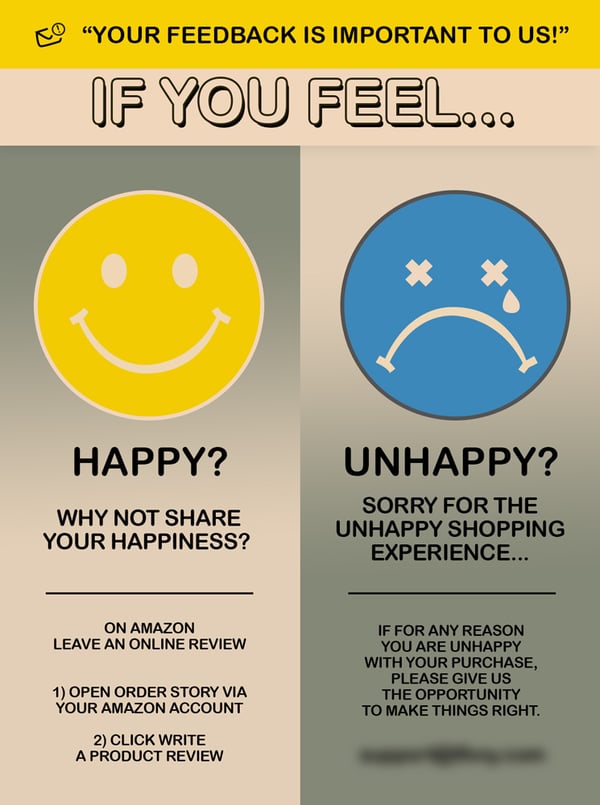
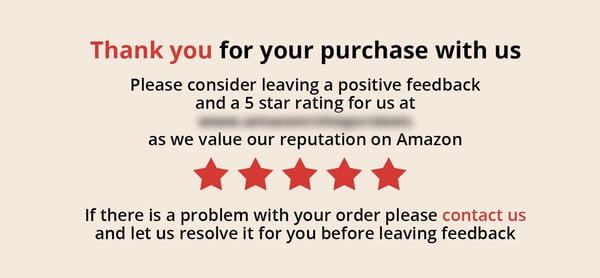
This used to be a recommended “hack” (always be wary of those) but now that Amazon has publicly put it on its radar, you can expect a swift—and probably severe—response.
If you sell on other sites, it can be really tempting to try and take your Amazon traffic there. However, Amazon is very serious about keeping customers and their purchases on its platform. Therefore, you can’t encourage customers to buy directly from your own website or on any other eCommerce channel.
Here it is in Amazon’s words:
You may not attempt to circumvent the Amazon sales process or divert Amazon customers to another website. This means that you may not provide links or messages that prompt users to visit any external website or complete a transaction elsewhere.
So, if you’re an omnichannel seller, always try to lead outside traffic to your Amazon store instead of vice versa.
Amazon goes to great lengths to protect the authenticity of reviews, ratings, and feedback and doesn’t tolerate any attempt to influence them. The Product Review Policy specifically states that inserting a request for a positive review or an incentive for a review into your product packaging or shipping box is prohibited. The issue is also addressed in the Seller Code of Conduct:
You may not attempt to influence or inflate customers’ ratings, feedback, and reviews. You may request feedback and reviews from your own customers in a neutral manner, but may not:
- Pay for or offer an incentive (such as coupons or free products) in exchange for providing or removing feedback or reviews
- Ask customers to write only positive reviews or ask them to remove or change a review
- Solicit reviews only from customers who had a positive experience
- Review your own products or a competitors’ products
This brings us to the use of coupons and discount codes. These are very popular, but here are three things you must remember that, at the time of this writing, seem to be okay in Amazon’s eyes:
This first example below probably would have been fine if the seller would have either a) just left instructions for a review or b) only offered the discount; having both here is the problem.
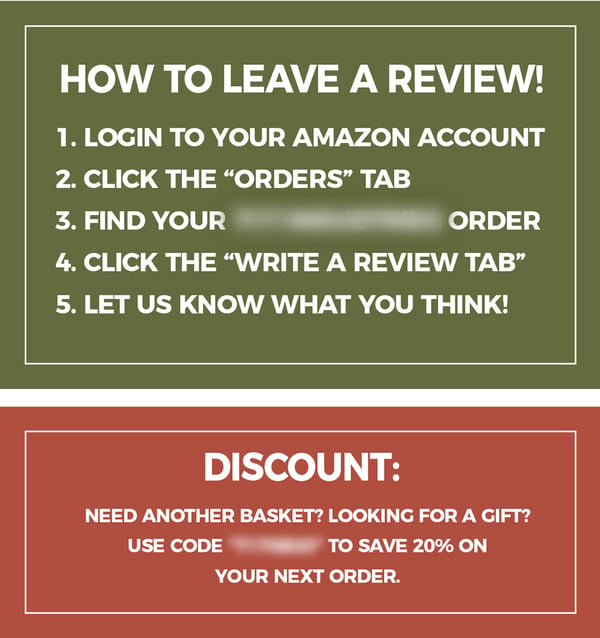
These last two examples break every rule we just discussed. Do the violations jump right out at you now that you’re more familiar with them?
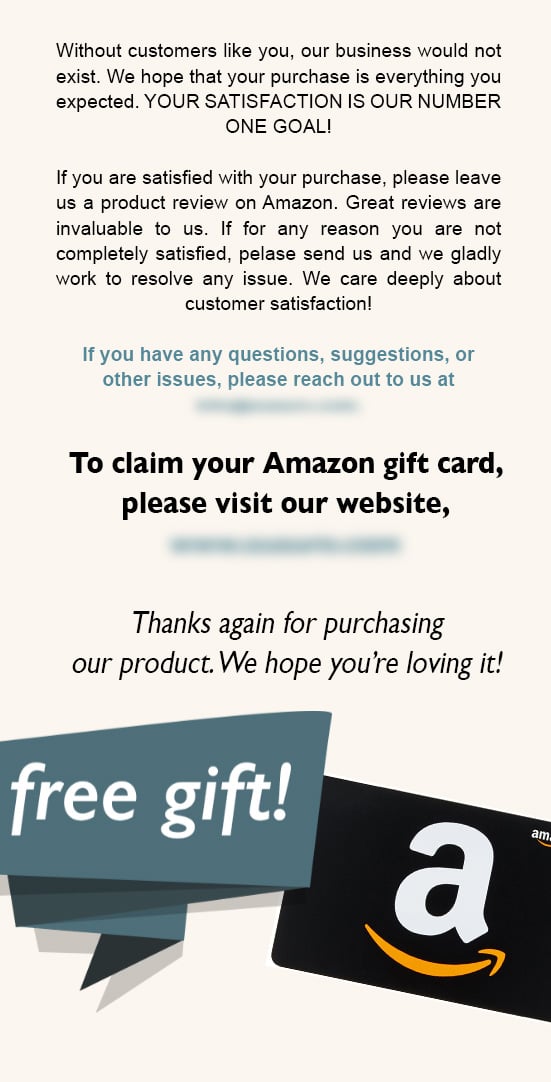
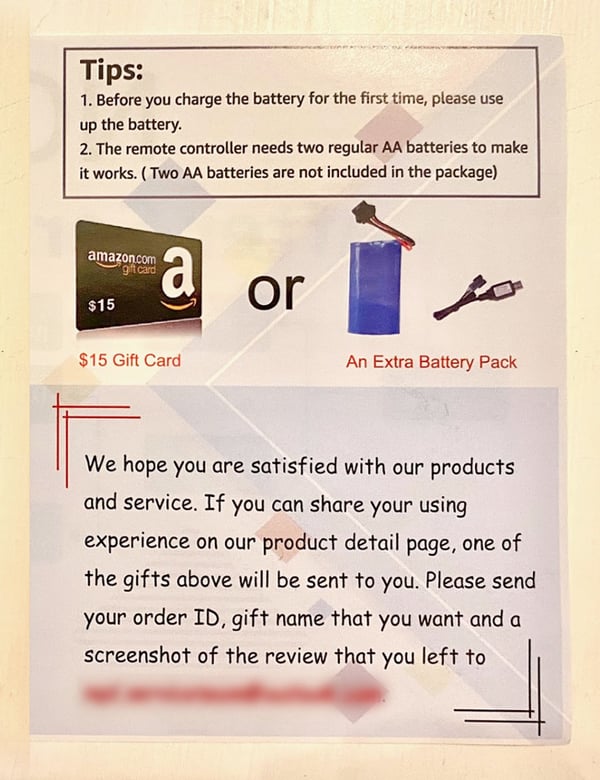
Before you print (or maybe reprint) your Amazon product inserts, stop to think about the two main objectives behind largely every Amazon policy: 1) to protect the integrity of product reviews and 2) to preserve the customer experience. Does your insert design threaten either of these things? If so, make some changes right now. A few more tips:
While you should always have multiple goals in mind, in this case it’s best to pick one and go for it. Are you aiming for a repeat purchase? Want more reviews? Tailor your insert accordingly. While you can keep them the same across the board, a more targeted approach may serve you well.
Sending any review request can be intimidating as compliance is always a top concern. With FeedbackFive, you can automate review requests through Buyer-Seller Messaging or the Request a Review button to ensure customers receive review requests with the correct link. Then, if your product insert is focused on review generation, you no longer have to waste valuable real estate on lengthy instructions for leaving a review. Or, since a review request is already being sent by FeedbackFive, you can focus your product insert messaging on other valuable information.
Inserts are a great opportunity to build brand loyalty and boost engagement. It’s also a time to get creative! Make your messaging eye-catching, easy to read, and minimal—no one is going to read a novel. Remind customers why they bought your product and what problem it solves. Share other uses, tips and tricks, and detailed use or assembly instructions if people might need more help. Excellent customer support and extra value adds can curb negative reviews and encourage repeat purchases. And another obvious but often skipped step—proofread and spellcheck, pretty please!
In most cases, your packaging insert isn’t going to be the magic bullet that immediately quadruples sales or review rates. A high-quality insert, coupled with a high-quality product, can certainly provide a boost, but you shouldn’t assume every single insert will garner your desired action. That’s just not realistic.
Again, we understand the policies surrounding product inserts leave a lot unsaid and can be interpreted differently. What works for one seller (or, most often, a big brand) may get you into trouble. There are extra hurdles with packaging requirements for FBA sellers, too. To make things even more complex, Amazon is also notorious for changing the rules with little or no notice. We always recommend that you regularly review program policies and be ready to adjust on the fly.
From what we’ve seen, it’s generally okay (at least for now) to have your website URL printed on your packaging. Some sellers will link to product videos or support pages as technically they're not sales related. To play it safe, you probably want to avoid listing any URL on your insert. Video instructions can easily go on your product page.
We understand your frustration! However, there’s a real chance of being reported by Amazon-savvy customers or even other sellers. The choice is yours, but always ask yourself if it's worth the risk.
Be very careful listing your website or social media links. The policy implies no outside URL is allowed. If you make the decision to add these, be very conscientious of your language, specifically the call to action. Consider linking only to your Amazon store. Promos should be exclusive to your Amazon products.
Amazon wants everything to stay on Amazon. That being said, do sellers do this? All the time. Again, you’re better off telling people how to contact you solely on Amazon, but if you choose to go this route, keep your contact information service-oriented.
Originally published on February 5, 2021, updated March 7, 2023
This post is accurate as of the date of publication. Some features and information may have changed due to product updates or Amazon policy changes.
These Stories on Feedback and Reviews
14321 Winter Breeze Drive
Suite 121 Midlothian, VA 23113
Call us: 800-757-6840





Copyright© 2007-2025 eComEngine, LLC. All Rights Reserved. eComEngine®, FeedbackFive®, RestockPro®, and SellerPulse® are trademarks or registered trademarks of eComEngine, LLC. Amazon's trademark is used under license from Amazon.com, Inc. or its affiliates.
No Comments Yet
Let us know what you think